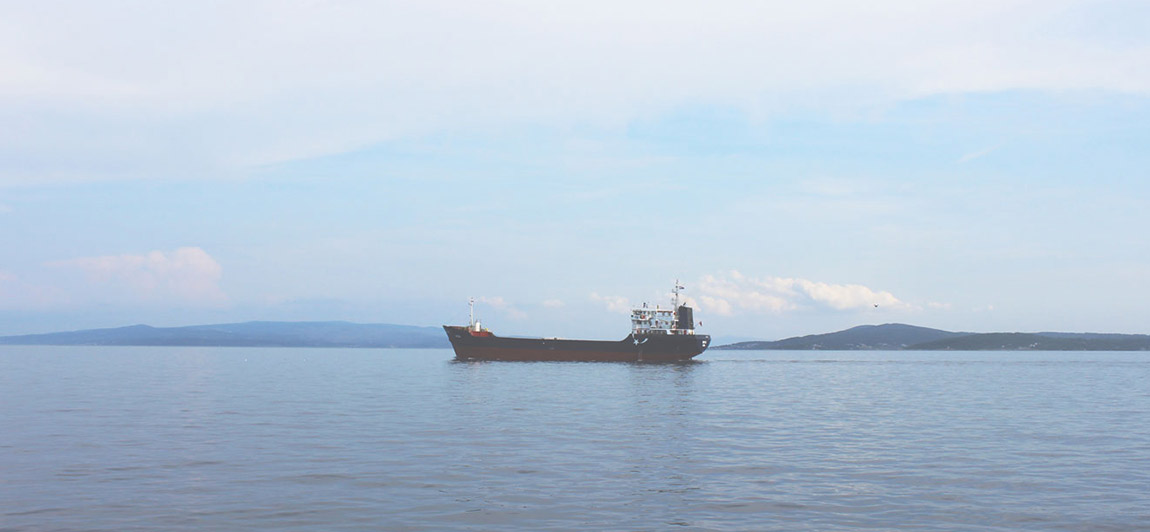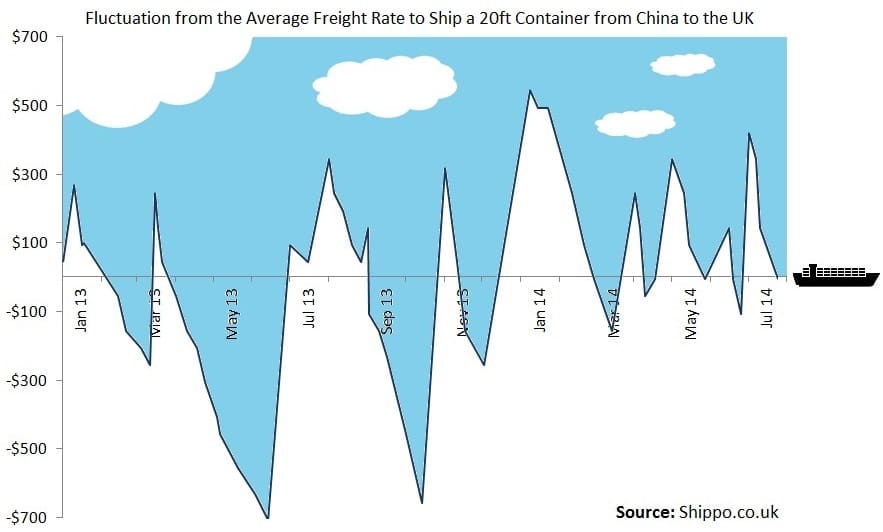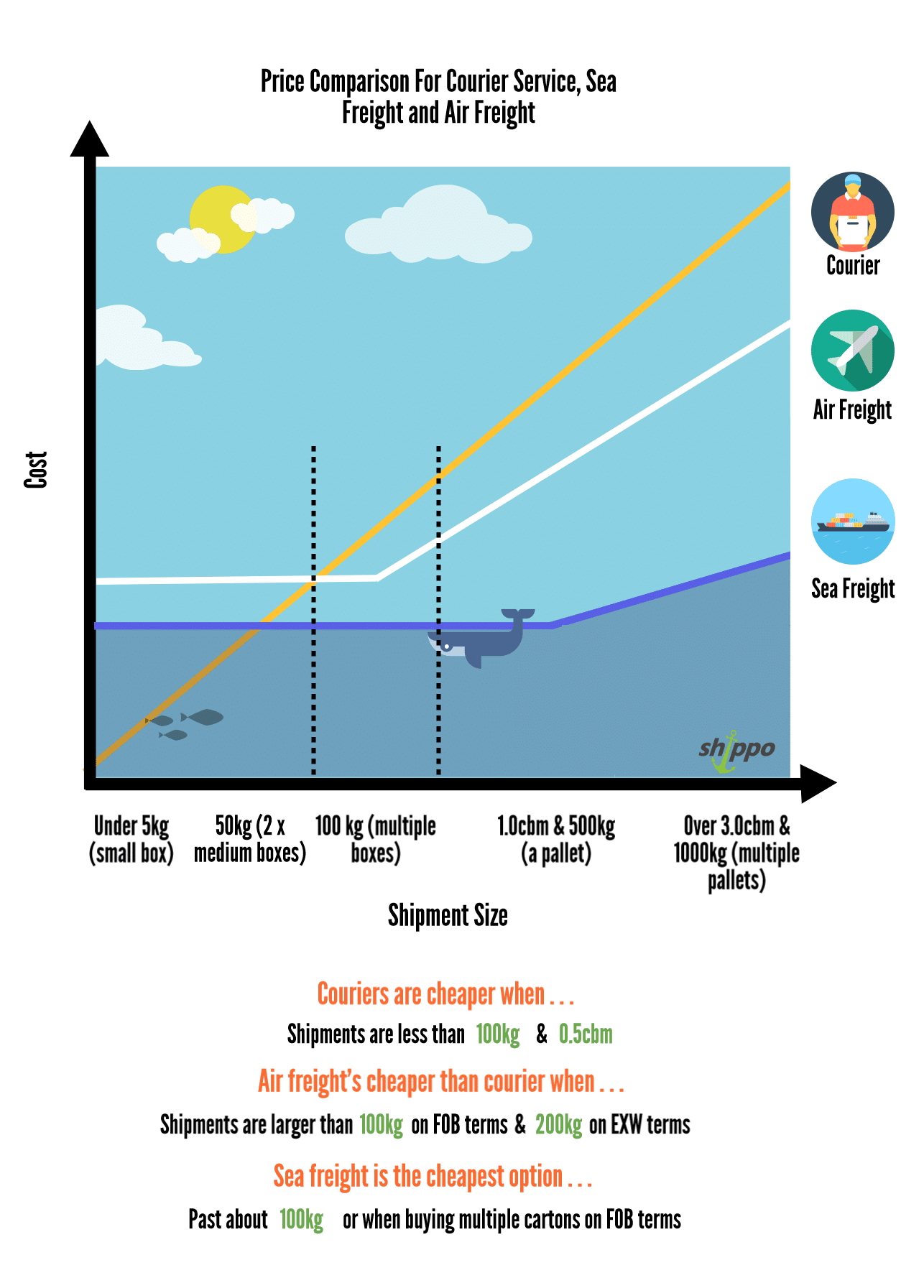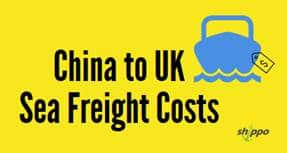Sea Freight Costs Explained
You’ll need to know how much sea freight costs before importing from China, India or elsewhere else!
A lot of the time you may receive very varied quotes on what you’re required to pay – but, before you rush in thinking you’re getting a great deal, you need to understand the process of importing goods from China to the UK. Once you understand the import fees, how much it costs and why, you can really see if you’re getting a good offer . . . or if there’s something dodgy going on. There are a lot of sea freight charges that need to be covered!
We’ve explained the entire importing process in detail here – so, if you’re looking into importing from China and you want to know what you’re really going to end up paying, we’d definitely recommend you give it a read.
We try to make our sea freight prices as simple as possible, but the below information is what you will need to get a quote from any shipping company:
- Weight and Dimensions/Volume of your goods
- Shipping terms that your supplier is offering (FOB, Exworks etc.)
- The outbound port (where the goods are coming from)
- Where the goods are being delivered to (location of your door!)
Sea freight costs are calculated by the volume or the weight (whichever is greatest). It’s normally the volume, which is why we need to know the dimensions of your shipment to get you a price.
The industry uses the technical term “Weight or Measure” – often shortened to “w/m”. This means that 1.0 cubic metre (cbm) is equivalent to 1000kg. It’s rare that the weight is so heavy that it indicates the cost, but if your shipment was 2.0cbm and 2500kg then the weight is greater than the volume. If it were 2.5cbm and 2000kg, then the volume is greater so the sea freight shipping rate would depend on that.
-
Different Ports Mean Different Costs
Sea freight rates vary from port to port. This can be due to a number of reasons, but it’s a good idea to know which port/s your supplier uses so you know the exact sea freight cost. If you’re shipping a pallet of goods from Guangzhou and your supplier is between the two, you could save money by importing it from Shenzhen which is less than 100 miles down the road.
Why the difference?
The size of the port is often a factor in the cost to ship goods by sea freight. Shanghai, for example, is the world’s busiest trading port which handles 32 million containers each year and therefore is cheaper than other Chinese ports due to economies of scale. Some ports, such as Zhongshan, don’t have services that run directly to the UK, so we have to arrange for a ‘feeder’ vessel to Hong Kong where the container is loaded onto the main ship; this additional transit would be an extra sea freight charge. Along with geography, these factors can cause the sea freight rates for shipping goods from China to vary quite a bit, so it’s always best to check if you have options with your supplier.Land locked
When importing goods from India, the factor of geography becomes very apparent. The two main ports that are used when importing from India are New Delhi and Mumbai. “But New Delhi is 1000km from the nearest sea” I hear you say . . . And you’d be right! As a result, the containers from the New Delhi CFS (Container Freight Station) have a sizable journey before they can be put on the boat ✔️ and that’s why the sea freight rates to import goods from New Delhi is often double what it’d be to import goods from Mumbai.
You should bear in mind that these fluctuations should only be minimal in the total shipping cost as, on FOB shipping terms, all the UK charges will be the same, so it may only make a difference of £10-20 per cubic metre, but every little helps.
-
Sea Freight Rates – Why so Unstable?
Why are the sea freight rates from China so unstable?” is one of the questions that crops up a lot when discussing full container load (FCL) shipments.
Part container load (LCL) shipments are not subject to such fluctuations. If you’re not shipping enough to fill a full container, it’s not likely that your shipping costs would vary by more than about £5-10 per cubic metre from month to month.
Shippo; Container Shipping Costs, Sea Freight Cost, Container Shipping Cost Calculator, Shipping Costs, trends
It’s not all Smooth Sailing for Full Container Loads
When shipping a full container, it’s very important to understand how the sea freight rates can vary. You could be left out of pocket if you don’t allow for rate fluctuations in your calculations. Before we try to explain the instability for FCL shipments from China to the UK, perhaps it’s best if we show you the statistics. The below graph shows how the sea freight shipping rate to import a 20ft container from China to the UK fluctuated from the average between January 2013 and July 2014:
As you can see from the graph, the sea freight rate for a 20ft container shipped from China to the UK varied by USD$1150 in a three month period from October 2013 and January 2014. If you checked the rate in October, based your calculations on that, commissioned your goods to be made (which may take 12 weeks) and then were ready to ship in January, then chances are you’d be pretty annoyed.
Why Are Sea Freights Rates So Unstable?
The reason for these huge peaks and troughs (increases and decreases in sea freight shipping rates) come as a result of the shipping lines artificially increasing the rates using large general rate increases (GRIs). These are implemented by all the shipping lines in order to stop the falling sea freight rates. Unfortunately, the volume of containers being shipped is rarely enough to hold the rate in its inflated state so the shipping lines then have to decrease their rates again to win business.
….. Until the rates are too low and the cycle continues.
-
Air and Sea Freight Costs
A major factor when deciding the method of importing your products to the UK is usually the import charges. Sea freight is usually 4-6 times cheaper than air freight.
When you’re deciding between traditional air/sea freight and a courier service (FedEx etc.), you will be best with a courier up to about 100kg in chargeable weight. When the shipment is larger than that, traditional air or sea freight will be most cost effective.
Weight is 6 times more dominant in air freight than in sea. 1 cbm (cubic metre) is equal to 1000kg in sea freight but for air freight 6 cbm is equal to 1000kg. If the weight of your cargo increases and you’re shipping by sea, it’s unlikely that the rate will increase much if at all. If you are importing heavy cargo via air freight, the cost difference between the two options will widen to much more than usual 4-6 fold.
How do you calculate the chargeable weight
- Sea Freight – Multiply the dimensions of the boxes (in metres) together then multiply that number by 1000. If this figure is larger than the weight then this is the chargeable weight.
(Example: if you have 8 boxes, each 0.5m x 0.5m x 0.5cm then the volumetric weight is 1000kg. If the boxes total 100kg then the chargeable weight is 1000kg, if they total 1500kg then the chargeable weight is 1500kg)
- Air Freight – Multiply the dimensions of the boxes (in metres) together then divide that figure by 6. If this is larger than the actual weight then that’s the chargeable weight.
(Example: if you have 8 boxes, each 0.5m x 0.5m x 0.5m then the volumetric weight is 166kg – (8 x 0.5×0.5×0.5) / 6. If the boxes total 100kg then the chargeable weight is 166kg, if they total 200kg then the chargeable weight is 200kg)
-
Competitive Quotes - The Real Story
At Shippo, we know just how easy importing goods via sea freight can and should be. However, the vast majority of shipping companies are very old fashioned in their approach to sea freight quotes. This can overly complicate the process of importing goods and add what we feel is an unnecessary complexity to sea freight. This only serves to give a smoke and mirrors effect to shipping in which customers can, maybe unintentionally, miss something and end up paying missing and hidden costs when the invoice arrives.
Watch Out!
If you’re sent a list of items that you’ll be paying that’s as long as your arm and include multiple acronyms that you’ve never heard before and aren’t ever likely to need, be aware. You should clarify that the costs include everything you need to get the goods to and from where you want and that you won’t be charged any more. We’ve explained why this happens (and how to avoid it!) in detail here.
The most frequent of the hidden costs is deferment. This is a cost that you can be charged for having the shipping company pay the UK Duty & VAT to HMRC on your behalf before billing it to you directly. We don’t think it’s fair, so our company don’t add anything on for this. However, deferment can often be charged as a percentage so this can be a huge extra cost. We recently quoted for a shipment where the customer had previously been stung for a deferment bill that was bigger than that for the actual freight costs!
Unless requested, we always give prices that include every foreseeable cost to get the goods from and to your desired origin and destination. Things that aren’t included are: duties, taxes and insurance (plus any unforeseeable costs that may come about in the rare event that customs hold your goods for a prolonged period of time, or you require the goods to be stored before delivery). However, we can help you calculate the duties and taxes you’ll have to pay and, with the value of your goods, we can give you a separate price for the insurance. So, while we can’t officially quote you all these charges (they’re third party charges, subject to HMRC), we can help you estimate them so you can budget your import charges.
The Problem
Imagine if you’d agreed a price and put down a deposit for a chair to be made in the UK. When you go to pick it up and pay the rest, the shop tells you that because they drove further than expected to get the wood they’ve doubled the price and the deposit is non-refundable. If they then told you that because they paid for the wood in advance this came with a surcharge too, I’m sure you’d be livid. With sea freight quotes, this can happen if shipping companies aren’t pinned down, so it’s very important to know exactly what it’s going to cost you to have your goods shipped, cleared through customs and delivered to your door.
Doing this allows you to control your costs when using FOB and EXW shipping terms, but if you have your supplier send the goods to the UK port (CIF, C&F, CFR) then the additional costs can be totally out of your control…. but that’s for another page.
-
UK Duties and Taxes
There’s one final thing to mention when discussing import charges. One of the largest costs when importing your goods from China (or anywhere else in the world) is UK Duty and VAT. Don’t forget about these – they can sometimes cost more than the freight!
UK Duty + VAT are taxes levied on imported goods by the government; unless your shipment is eligible for a duty relief scheme, there is no way of getting out of paying them. When your goods reach the UK and are cleared through customs, there will be an invoice with your UK Duty + VAT import charges that you’ll be required to pay before your goods are released to you.
We don’t include UK Duty + VAT in our sea freight quotes because it’s not a cost that we charge, control or collect; HMRC is responsible for your UK Duty + VAT and, while we can pay it on your behalf, the money goes straight into their pocket. While we cannot officially quote you UK Duty + VAT, we can assist you in estimating how much your Duty & VAT will be.
Here’s our guide to working out the amount of UK Duty & VAT you’ll have to pay on your import.
Shippo; freight shipping cost, trends
Additional FAQ’s asked and answered by Shippo
Here is our answer to number of the following similar questions we are often asked ie…
What are typical container shipping rates? How much does it cost to ship a container? What’s it cost to ship a cargo container? How much does it cost to ship a shipping container to Europe?
The cost to import a container from China to you in the UK mainly depends on the shipping terms you’ve agreed with your supplier and the size of the container. To get an accurate rate it’s best to wait until the shipment is nearly ready. This is because the shipping lines regularly change their rates and we have seen the rates changing every 2 weeks over the past year.
How much does it cost to bring a 40 foot container from China?
The cost to import a 40ft container from China to you in the UK will depend on your delivery location and the shipping terms you agree with your supplier. If you’re in the planning stage and have bought your goods on FOB shipping terms you can work on £13,000 – £15,000 + UK Duty & VAT although this will fluctuate based on availability. This shouldn’t be far out, but it could be lower.
How much does it cost to bring a 20 foot container from China?
The cost to import a 20ft container from China to your premises in the UK will depend on the shipping terms you buy the goods on and your exact delivery location. If you’re in the planning stage and are planning to buy your goods on FOB shipping terms you can work on £9,000 – £10,000 + UK Duty & VAT, although this will fluctuate. This shouldn’t be far out, but it could be lower.
How to calculate ocean freight charges? How much to ship to uk?
If you’re not importing enough to fill a shipping container there are a few variables that control your importing costs. The size of the shipment, the shipping terms you agree with your supplier, and the delivery location. The rates have been increasing every 2 weeks over the last year so our rates are valid until the end of the month. Please get in touch with us with these details so we can put together a quote for you, which we can provide you with promptly.





